Analysis of Reductionist and Complexity Approaches in Systems
VerifiedAdded on 2020/04/15
|9
|1875
|36
Report
AI Summary
This report delves into the contrasting philosophies of reductionist and complexity approaches in systems analysis. It begins by outlining the fundamental differences between these two perspectives, highlighting the limitations of reductionism when dealing with complex systems, such as human emotions and chaotic phenomena. The report then explores the consequences of failing to recognize complexity, using examples like flocking birds and the human brain to illustrate the inadequacy of reductionist methods in understanding intricate systems. Furthermore, it presents the application of systems techniques to address specific problems, including acquiring land for a new facility and dealing with student plagiarism. The analysis demonstrates how the complexity approach is essential for understanding human behavior and other complex systems. The conclusion reinforces the necessity of the complexity approach in situations where reductionist theories fall short, emphasizing that while reductionism offers a simpler framework, complexity is crucial for analyzing intricate systems.

Running head: REDUCTIONIST AND COMPLEXITY APPROACH IN SYSTEMS
Reductionist and Complexity Approach in Systems
Name of the Student
Name of the University
Author Note
Reductionist and Complexity Approach in Systems
Name of the Student
Name of the University
Author Note
Paraphrase This Document
Need a fresh take? Get an instant paraphrase of this document with our AI Paraphraser
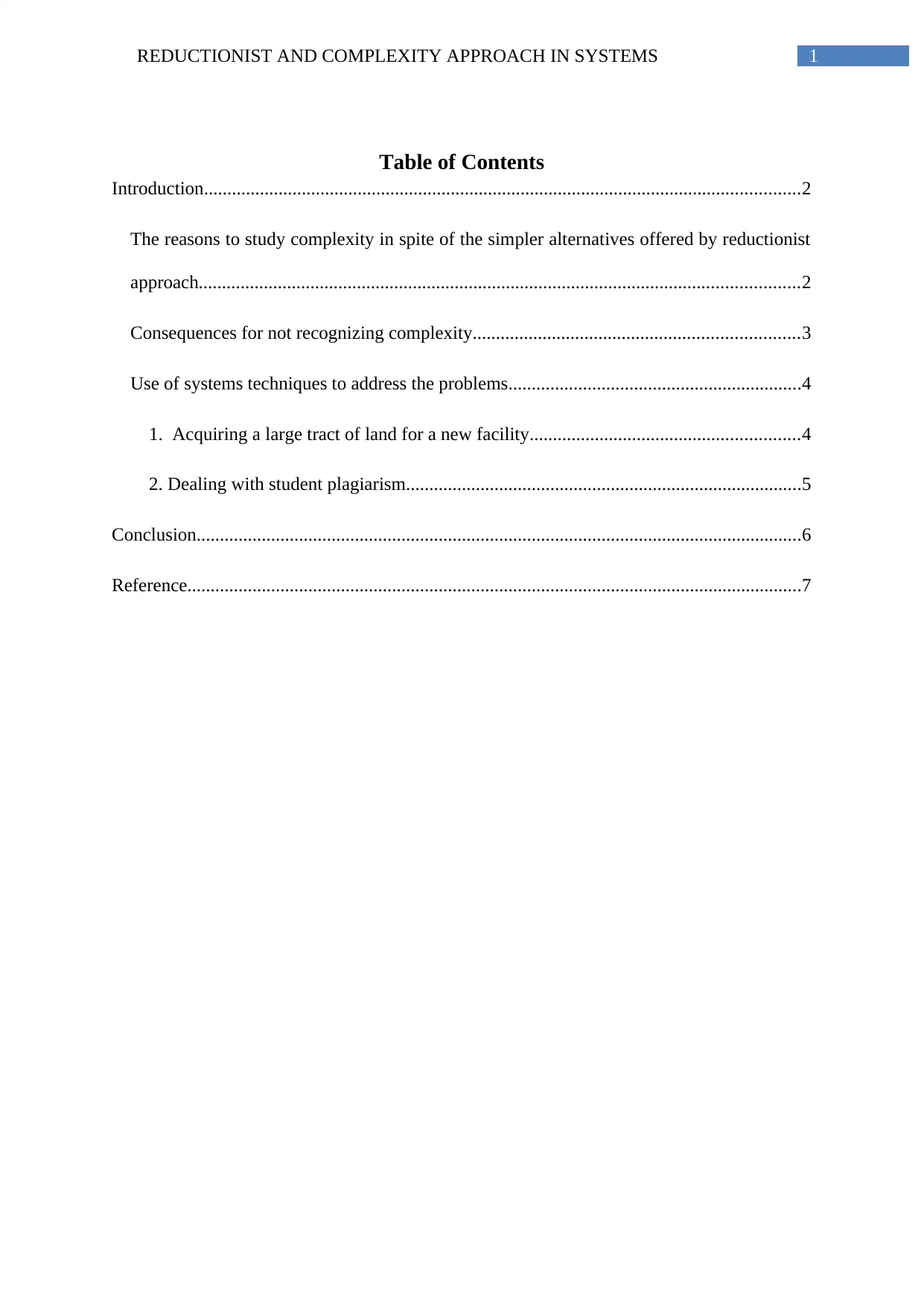
1REDUCTIONIST AND COMPLEXITY APPROACH IN SYSTEMS
Table of Contents
Introduction................................................................................................................................2
The reasons to study complexity in spite of the simpler alternatives offered by reductionist
approach.................................................................................................................................2
Consequences for not recognizing complexity......................................................................3
Use of systems techniques to address the problems...............................................................4
1. Acquiring a large tract of land for a new facility..........................................................4
2. Dealing with student plagiarism.....................................................................................5
Conclusion..................................................................................................................................6
Reference....................................................................................................................................7
Table of Contents
Introduction................................................................................................................................2
The reasons to study complexity in spite of the simpler alternatives offered by reductionist
approach.................................................................................................................................2
Consequences for not recognizing complexity......................................................................3
Use of systems techniques to address the problems...............................................................4
1. Acquiring a large tract of land for a new facility..........................................................4
2. Dealing with student plagiarism.....................................................................................5
Conclusion..................................................................................................................................6
Reference....................................................................................................................................7

2REDUCTIONIST AND COMPLEXITY APPROACH IN SYSTEMS
Introduction
The way that system thinking has been developed in many ways since its inception,
scholars have tried to understand the theories of reductionist and complexity. Reductionist
theories had emerged in the 20th Century, which had influenced the thinking of Western
culture. The form of reductionism follows the idea that the processes existing in the universe
can be disintegrated. On the other hand, complexity deals with the behavioural properties of a
system (Asano, Engel and Baumeister 2016). The following report would focus on the factual
differences between the approaches of reductionism and complexity. The report would
include the reasons to study complexity in spite of the presence of simpler alternatives
offered by reductionism, the problems that could arise for not recognising complexity in a
system and the use of systems techniques to address to the problems of dealing with student
plagiarism and acquiring a large tract of land for a new facility.
The reasons to study complexity in spite of the simpler alternatives offered by
reductionist approach
Systems can be defined as the set of entities, which could be unified into a whole
through dependencies, interactions and relationships. Complex systems deal with the
behavioural properties of a system. Alternatively, reductionist theory believes in the idea of
scientifically disintegrating a system or a process into their constituent parts. This is to put
forward the idea that every system is explainable with the reductionist theory.
However, the reductionist theory also has its limitations. Many scientific approaches
define the reductionist theory as inapplicable since there is presence of too complex systems
in the universe that could be disintegrated into numbers (Fardet 2017). For example, if we
take human emotions into account, it would be so difficult that it would never be easily
Introduction
The way that system thinking has been developed in many ways since its inception,
scholars have tried to understand the theories of reductionist and complexity. Reductionist
theories had emerged in the 20th Century, which had influenced the thinking of Western
culture. The form of reductionism follows the idea that the processes existing in the universe
can be disintegrated. On the other hand, complexity deals with the behavioural properties of a
system (Asano, Engel and Baumeister 2016). The following report would focus on the factual
differences between the approaches of reductionism and complexity. The report would
include the reasons to study complexity in spite of the presence of simpler alternatives
offered by reductionism, the problems that could arise for not recognising complexity in a
system and the use of systems techniques to address to the problems of dealing with student
plagiarism and acquiring a large tract of land for a new facility.
The reasons to study complexity in spite of the simpler alternatives offered by
reductionist approach
Systems can be defined as the set of entities, which could be unified into a whole
through dependencies, interactions and relationships. Complex systems deal with the
behavioural properties of a system. Alternatively, reductionist theory believes in the idea of
scientifically disintegrating a system or a process into their constituent parts. This is to put
forward the idea that every system is explainable with the reductionist theory.
However, the reductionist theory also has its limitations. Many scientific approaches
define the reductionist theory as inapplicable since there is presence of too complex systems
in the universe that could be disintegrated into numbers (Fardet 2017). For example, if we
take human emotions into account, it would be so difficult that it would never be easily
⊘ This is a preview!⊘
Do you want full access?
Subscribe today to unlock all pages.

Trusted by 1+ million students worldwide
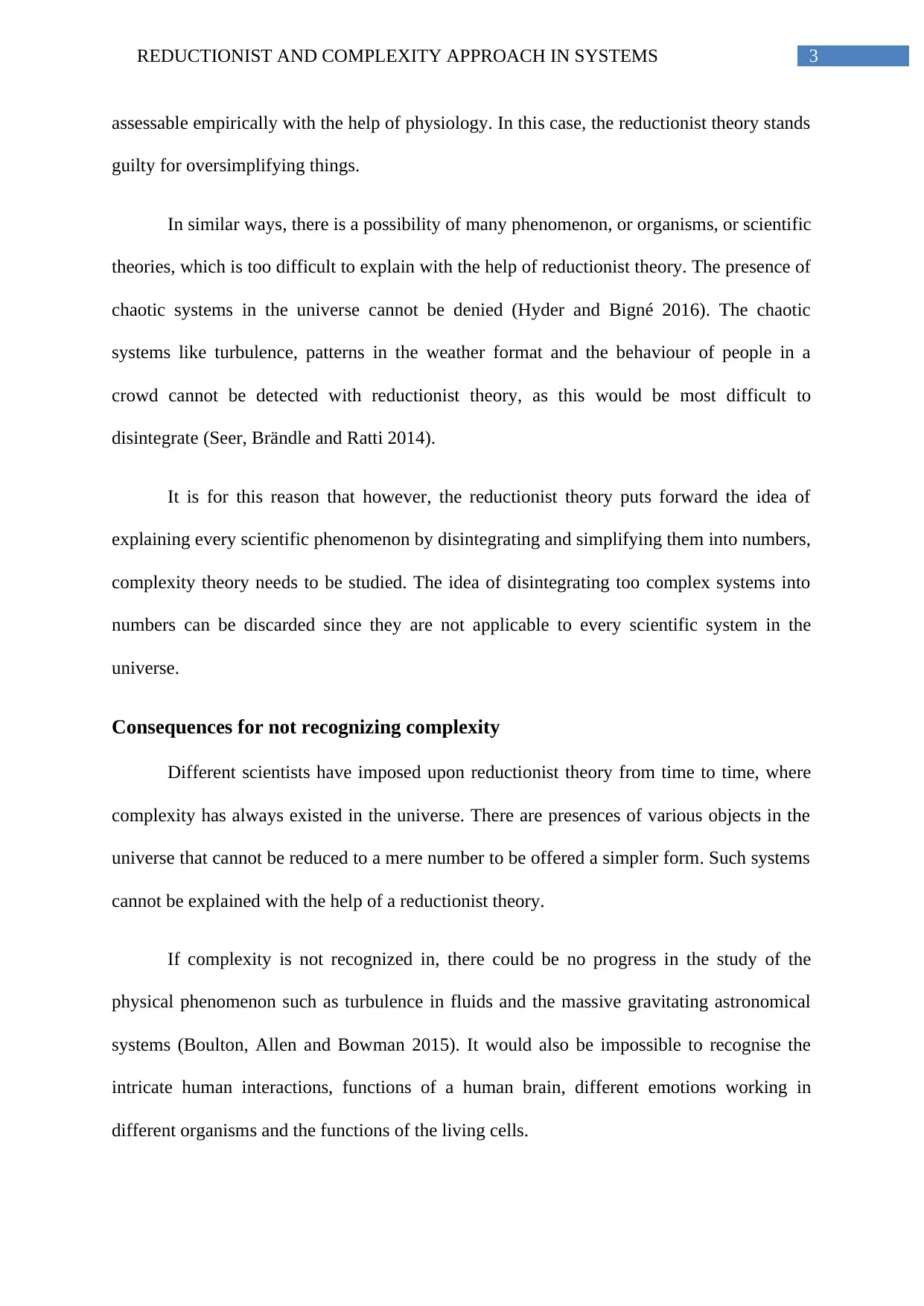
3REDUCTIONIST AND COMPLEXITY APPROACH IN SYSTEMS
assessable empirically with the help of physiology. In this case, the reductionist theory stands
guilty for oversimplifying things.
In similar ways, there is a possibility of many phenomenon, or organisms, or scientific
theories, which is too difficult to explain with the help of reductionist theory. The presence of
chaotic systems in the universe cannot be denied (Hyder and Bigné 2016). The chaotic
systems like turbulence, patterns in the weather format and the behaviour of people in a
crowd cannot be detected with reductionist theory, as this would be most difficult to
disintegrate (Seer, Brändle and Ratti 2014).
It is for this reason that however, the reductionist theory puts forward the idea of
explaining every scientific phenomenon by disintegrating and simplifying them into numbers,
complexity theory needs to be studied. The idea of disintegrating too complex systems into
numbers can be discarded since they are not applicable to every scientific system in the
universe.
Consequences for not recognizing complexity
Different scientists have imposed upon reductionist theory from time to time, where
complexity has always existed in the universe. There are presences of various objects in the
universe that cannot be reduced to a mere number to be offered a simpler form. Such systems
cannot be explained with the help of a reductionist theory.
If complexity is not recognized in, there could be no progress in the study of the
physical phenomenon such as turbulence in fluids and the massive gravitating astronomical
systems (Boulton, Allen and Bowman 2015). It would also be impossible to recognise the
intricate human interactions, functions of a human brain, different emotions working in
different organisms and the functions of the living cells.
assessable empirically with the help of physiology. In this case, the reductionist theory stands
guilty for oversimplifying things.
In similar ways, there is a possibility of many phenomenon, or organisms, or scientific
theories, which is too difficult to explain with the help of reductionist theory. The presence of
chaotic systems in the universe cannot be denied (Hyder and Bigné 2016). The chaotic
systems like turbulence, patterns in the weather format and the behaviour of people in a
crowd cannot be detected with reductionist theory, as this would be most difficult to
disintegrate (Seer, Brändle and Ratti 2014).
It is for this reason that however, the reductionist theory puts forward the idea of
explaining every scientific phenomenon by disintegrating and simplifying them into numbers,
complexity theory needs to be studied. The idea of disintegrating too complex systems into
numbers can be discarded since they are not applicable to every scientific system in the
universe.
Consequences for not recognizing complexity
Different scientists have imposed upon reductionist theory from time to time, where
complexity has always existed in the universe. There are presences of various objects in the
universe that cannot be reduced to a mere number to be offered a simpler form. Such systems
cannot be explained with the help of a reductionist theory.
If complexity is not recognized in, there could be no progress in the study of the
physical phenomenon such as turbulence in fluids and the massive gravitating astronomical
systems (Boulton, Allen and Bowman 2015). It would also be impossible to recognise the
intricate human interactions, functions of a human brain, different emotions working in
different organisms and the functions of the living cells.
Paraphrase This Document
Need a fresh take? Get an instant paraphrase of this document with our AI Paraphraser
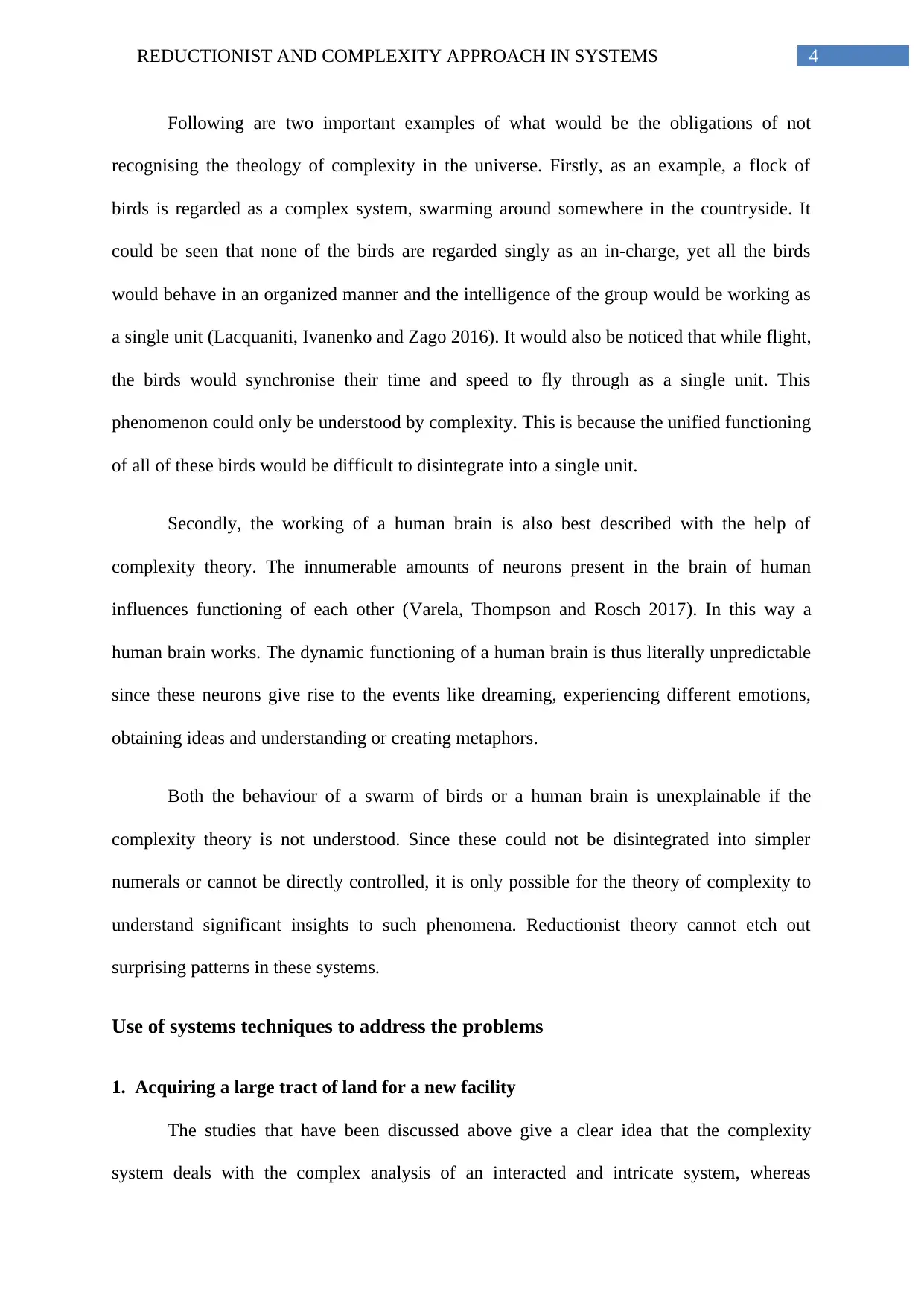
4REDUCTIONIST AND COMPLEXITY APPROACH IN SYSTEMS
Following are two important examples of what would be the obligations of not
recognising the theology of complexity in the universe. Firstly, as an example, a flock of
birds is regarded as a complex system, swarming around somewhere in the countryside. It
could be seen that none of the birds are regarded singly as an in-charge, yet all the birds
would behave in an organized manner and the intelligence of the group would be working as
a single unit (Lacquaniti, Ivanenko and Zago 2016). It would also be noticed that while flight,
the birds would synchronise their time and speed to fly through as a single unit. This
phenomenon could only be understood by complexity. This is because the unified functioning
of all of these birds would be difficult to disintegrate into a single unit.
Secondly, the working of a human brain is also best described with the help of
complexity theory. The innumerable amounts of neurons present in the brain of human
influences functioning of each other (Varela, Thompson and Rosch 2017). In this way a
human brain works. The dynamic functioning of a human brain is thus literally unpredictable
since these neurons give rise to the events like dreaming, experiencing different emotions,
obtaining ideas and understanding or creating metaphors.
Both the behaviour of a swarm of birds or a human brain is unexplainable if the
complexity theory is not understood. Since these could not be disintegrated into simpler
numerals or cannot be directly controlled, it is only possible for the theory of complexity to
understand significant insights to such phenomena. Reductionist theory cannot etch out
surprising patterns in these systems.
Use of systems techniques to address the problems
1. Acquiring a large tract of land for a new facility
The studies that have been discussed above give a clear idea that the complexity
system deals with the complex analysis of an interacted and intricate system, whereas
Following are two important examples of what would be the obligations of not
recognising the theology of complexity in the universe. Firstly, as an example, a flock of
birds is regarded as a complex system, swarming around somewhere in the countryside. It
could be seen that none of the birds are regarded singly as an in-charge, yet all the birds
would behave in an organized manner and the intelligence of the group would be working as
a single unit (Lacquaniti, Ivanenko and Zago 2016). It would also be noticed that while flight,
the birds would synchronise their time and speed to fly through as a single unit. This
phenomenon could only be understood by complexity. This is because the unified functioning
of all of these birds would be difficult to disintegrate into a single unit.
Secondly, the working of a human brain is also best described with the help of
complexity theory. The innumerable amounts of neurons present in the brain of human
influences functioning of each other (Varela, Thompson and Rosch 2017). In this way a
human brain works. The dynamic functioning of a human brain is thus literally unpredictable
since these neurons give rise to the events like dreaming, experiencing different emotions,
obtaining ideas and understanding or creating metaphors.
Both the behaviour of a swarm of birds or a human brain is unexplainable if the
complexity theory is not understood. Since these could not be disintegrated into simpler
numerals or cannot be directly controlled, it is only possible for the theory of complexity to
understand significant insights to such phenomena. Reductionist theory cannot etch out
surprising patterns in these systems.
Use of systems techniques to address the problems
1. Acquiring a large tract of land for a new facility
The studies that have been discussed above give a clear idea that the complexity
system deals with the complex analysis of an interacted and intricate system, whereas

5REDUCTIONIST AND COMPLEXITY APPROACH IN SYSTEMS
reductionist theory deals with disintegrating a system into simpler forms to deduce numbers
from it.
A piece of land is a system that could be disintegrated into different simpler systems
to acquire a numerical form. The facilities to be installed also are a system capable of
disintegration into simpler numerical forms (Van Manen 2016). Thus if the entire system of a
land is considered where a new facility needs to be installed could be understood and
addressed with the help of a reductionist theory. However, if it were tried to implement a
complexity approach in this regard, the system would not be able to be amicable since there
is no presence of a complex system that is impossible to be explained in numbers.
2. Dealing with student plagiarism
Plagiarism is a phenomenon best defined as mulling over someone else’s task or ideas
or work as own. However, this is illegal in approach, yet there are certain occurrences of this
phenomenon (Rapp 2015). Copying someone’s ideas and work as own and not
acknowledging the original work is a complexity of human brain, which gives rise to the
thought of plagiarising. Thus, it depends on the functioning of a human brain that a person
plagiarises. Any function that a human brain performs depends upon the dynamic function of
the neurons present in a human brain.
Human emotions and behaviour falls under the complex systems, which can only be
described by complexity approach (Bara 2016). The patterns and tendencies in students to
perform plagiarism can only be scrutinized through a complex system approach. The pattern
however, could not be predicted by a specific theory since human brain is impossible to
perceive specifically.
reductionist theory deals with disintegrating a system into simpler forms to deduce numbers
from it.
A piece of land is a system that could be disintegrated into different simpler systems
to acquire a numerical form. The facilities to be installed also are a system capable of
disintegration into simpler numerical forms (Van Manen 2016). Thus if the entire system of a
land is considered where a new facility needs to be installed could be understood and
addressed with the help of a reductionist theory. However, if it were tried to implement a
complexity approach in this regard, the system would not be able to be amicable since there
is no presence of a complex system that is impossible to be explained in numbers.
2. Dealing with student plagiarism
Plagiarism is a phenomenon best defined as mulling over someone else’s task or ideas
or work as own. However, this is illegal in approach, yet there are certain occurrences of this
phenomenon (Rapp 2015). Copying someone’s ideas and work as own and not
acknowledging the original work is a complexity of human brain, which gives rise to the
thought of plagiarising. Thus, it depends on the functioning of a human brain that a person
plagiarises. Any function that a human brain performs depends upon the dynamic function of
the neurons present in a human brain.
Human emotions and behaviour falls under the complex systems, which can only be
described by complexity approach (Bara 2016). The patterns and tendencies in students to
perform plagiarism can only be scrutinized through a complex system approach. The pattern
however, could not be predicted by a specific theory since human brain is impossible to
perceive specifically.
⊘ This is a preview!⊘
Do you want full access?
Subscribe today to unlock all pages.

Trusted by 1+ million students worldwide
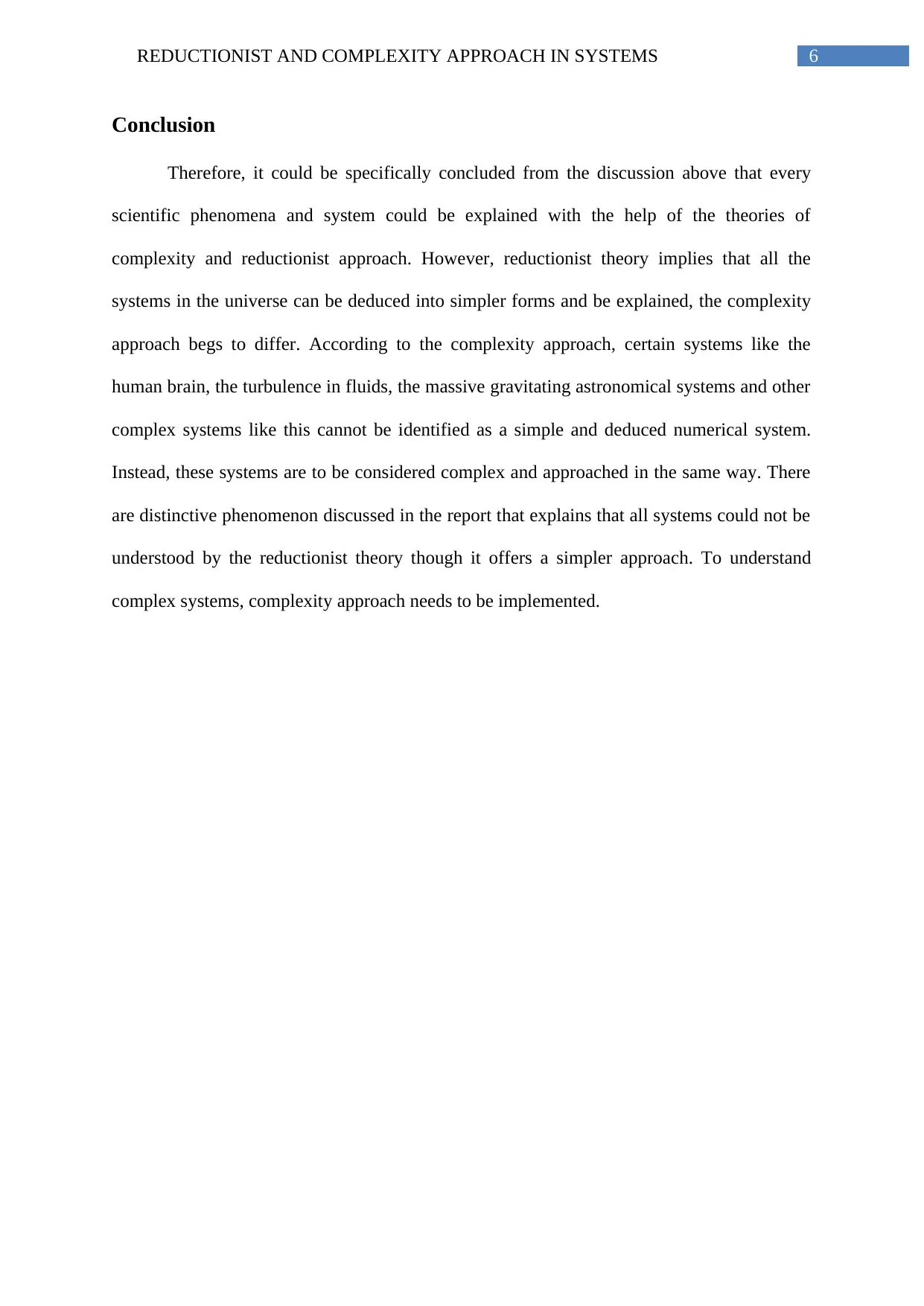
6REDUCTIONIST AND COMPLEXITY APPROACH IN SYSTEMS
Conclusion
Therefore, it could be specifically concluded from the discussion above that every
scientific phenomena and system could be explained with the help of the theories of
complexity and reductionist approach. However, reductionist theory implies that all the
systems in the universe can be deduced into simpler forms and be explained, the complexity
approach begs to differ. According to the complexity approach, certain systems like the
human brain, the turbulence in fluids, the massive gravitating astronomical systems and other
complex systems like this cannot be identified as a simple and deduced numerical system.
Instead, these systems are to be considered complex and approached in the same way. There
are distinctive phenomenon discussed in the report that explains that all systems could not be
understood by the reductionist theory though it offers a simpler approach. To understand
complex systems, complexity approach needs to be implemented.
Conclusion
Therefore, it could be specifically concluded from the discussion above that every
scientific phenomena and system could be explained with the help of the theories of
complexity and reductionist approach. However, reductionist theory implies that all the
systems in the universe can be deduced into simpler forms and be explained, the complexity
approach begs to differ. According to the complexity approach, certain systems like the
human brain, the turbulence in fluids, the massive gravitating astronomical systems and other
complex systems like this cannot be identified as a simple and deduced numerical system.
Instead, these systems are to be considered complex and approached in the same way. There
are distinctive phenomenon discussed in the report that explains that all systems could not be
understood by the reductionist theory though it offers a simpler approach. To understand
complex systems, complexity approach needs to be implemented.
Paraphrase This Document
Need a fresh take? Get an instant paraphrase of this document with our AI Paraphraser
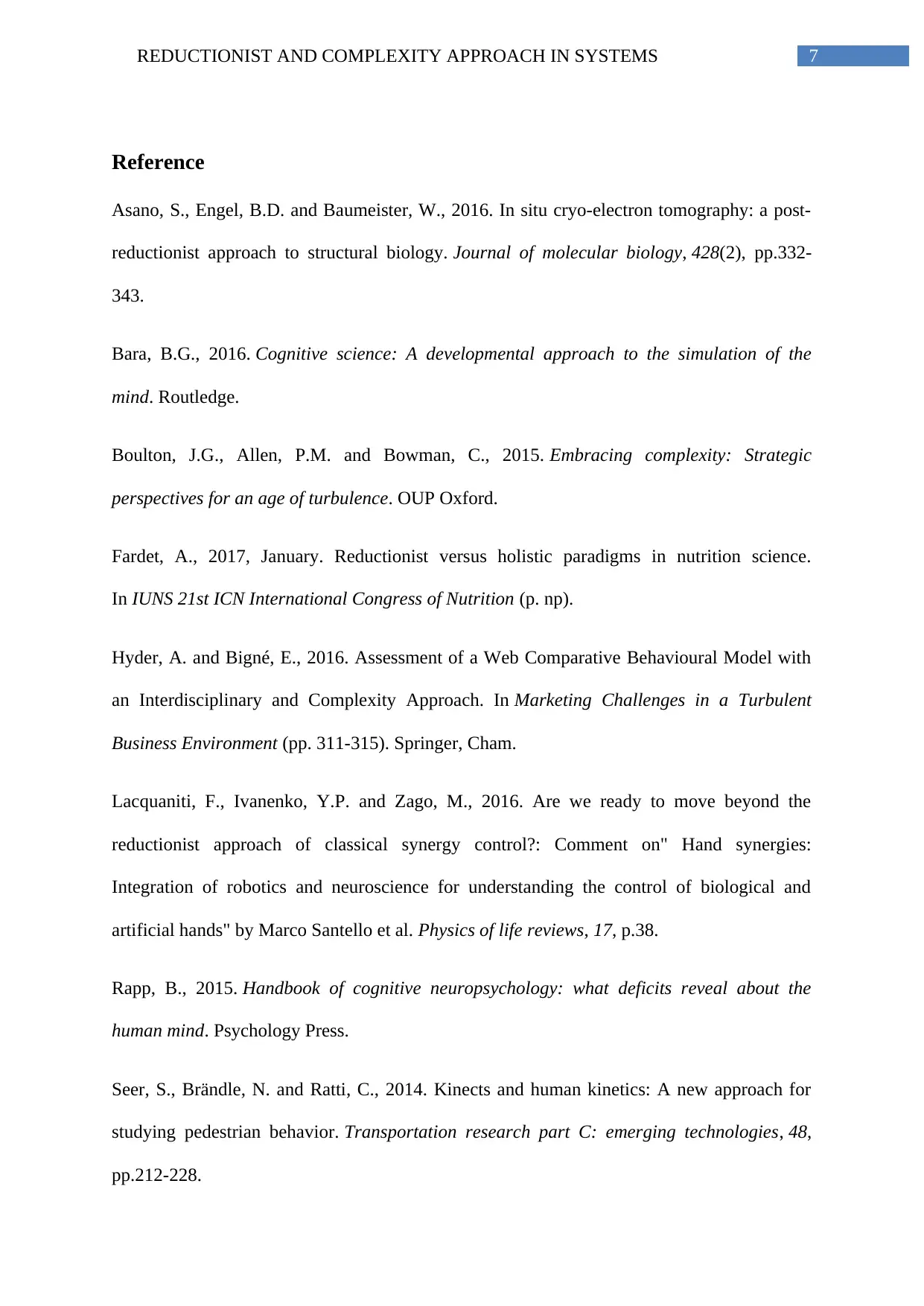
7REDUCTIONIST AND COMPLEXITY APPROACH IN SYSTEMS
Reference
Asano, S., Engel, B.D. and Baumeister, W., 2016. In situ cryo-electron tomography: a post-
reductionist approach to structural biology. Journal of molecular biology, 428(2), pp.332-
343.
Bara, B.G., 2016. Cognitive science: A developmental approach to the simulation of the
mind. Routledge.
Boulton, J.G., Allen, P.M. and Bowman, C., 2015. Embracing complexity: Strategic
perspectives for an age of turbulence. OUP Oxford.
Fardet, A., 2017, January. Reductionist versus holistic paradigms in nutrition science.
In IUNS 21st ICN International Congress of Nutrition (p. np).
Hyder, A. and Bigné, E., 2016. Assessment of a Web Comparative Behavioural Model with
an Interdisciplinary and Complexity Approach. In Marketing Challenges in a Turbulent
Business Environment (pp. 311-315). Springer, Cham.
Lacquaniti, F., Ivanenko, Y.P. and Zago, M., 2016. Are we ready to move beyond the
reductionist approach of classical synergy control?: Comment on" Hand synergies:
Integration of robotics and neuroscience for understanding the control of biological and
artificial hands" by Marco Santello et al. Physics of life reviews, 17, p.38.
Rapp, B., 2015. Handbook of cognitive neuropsychology: what deficits reveal about the
human mind. Psychology Press.
Seer, S., Brändle, N. and Ratti, C., 2014. Kinects and human kinetics: A new approach for
studying pedestrian behavior. Transportation research part C: emerging technologies, 48,
pp.212-228.
Reference
Asano, S., Engel, B.D. and Baumeister, W., 2016. In situ cryo-electron tomography: a post-
reductionist approach to structural biology. Journal of molecular biology, 428(2), pp.332-
343.
Bara, B.G., 2016. Cognitive science: A developmental approach to the simulation of the
mind. Routledge.
Boulton, J.G., Allen, P.M. and Bowman, C., 2015. Embracing complexity: Strategic
perspectives for an age of turbulence. OUP Oxford.
Fardet, A., 2017, January. Reductionist versus holistic paradigms in nutrition science.
In IUNS 21st ICN International Congress of Nutrition (p. np).
Hyder, A. and Bigné, E., 2016. Assessment of a Web Comparative Behavioural Model with
an Interdisciplinary and Complexity Approach. In Marketing Challenges in a Turbulent
Business Environment (pp. 311-315). Springer, Cham.
Lacquaniti, F., Ivanenko, Y.P. and Zago, M., 2016. Are we ready to move beyond the
reductionist approach of classical synergy control?: Comment on" Hand synergies:
Integration of robotics and neuroscience for understanding the control of biological and
artificial hands" by Marco Santello et al. Physics of life reviews, 17, p.38.
Rapp, B., 2015. Handbook of cognitive neuropsychology: what deficits reveal about the
human mind. Psychology Press.
Seer, S., Brändle, N. and Ratti, C., 2014. Kinects and human kinetics: A new approach for
studying pedestrian behavior. Transportation research part C: emerging technologies, 48,
pp.212-228.

8REDUCTIONIST AND COMPLEXITY APPROACH IN SYSTEMS
Van Manen, M., 2016. Researching lived experience: Human science for an action sensitive
pedagogy. Routledge.
Varela, F.J., Thompson, E. and Rosch, E., 2017. The embodied mind: Cognitive science and
human experience. MIT press.
Van Manen, M., 2016. Researching lived experience: Human science for an action sensitive
pedagogy. Routledge.
Varela, F.J., Thompson, E. and Rosch, E., 2017. The embodied mind: Cognitive science and
human experience. MIT press.
⊘ This is a preview!⊘
Do you want full access?
Subscribe today to unlock all pages.

Trusted by 1+ million students worldwide
1 out of 9
Your All-in-One AI-Powered Toolkit for Academic Success.
+13062052269
info@desklib.com
Available 24*7 on WhatsApp / Email
![[object Object]](/_next/static/media/star-bottom.7253800d.svg)
Unlock your academic potential
Copyright © 2020–2025 A2Z Services. All Rights Reserved. Developed and managed by ZUCOL.
